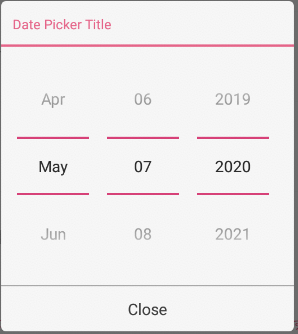Unfortunately, this is not a trivial task.
DatePickers use widgets NumberPicker and CalendarView internally. For instance, the image you have posted is using 3 NumberPickers. And the dividers you are talking about come from NumberPicker's attribute: selectionDivider. The problem is that this attribute is not public, and neither is numberPickerStyle, through which, this attribute is set.
I recently back-ported CalendarView and NumberPicker to API 8, mostly for fun. Since the code is readily available(look up android.widget.NumberPicker and others in android's source), all this task takes is time, and some digging through android's source-code. Examples:
Easy ==> You'll have to change the private variable from View class to their accessor methods
mLeft (protected variable in View class) ==> getLeft() (public accessor method)
The most time-consuming task was restoring the Accessibility methods.
In any case, if you do decide on writing custom implementation of DatePicker, you'll have to write them for NumberPicker and CalendarView (optionally) as well.
Easier way:
Backported DatePicker is available as a library here: Android-DatePicker. As mentioned above, you'll be using backported CalendarView and NumberPicker in conjunction with this DatePicker.
What you need to change:
Use {library-numberpicker} / res / drawable-xxxx / np_numberpicker_selection_divider.9.png as a template, and change the 'bluish' color to green (I used pixlr). You can either save it with the same name, if you want to be done with the blue divider altogether, or use a different name and make changes in {library-numberpicker} / res / values / themes.xml.
The changes required in themes.xml if you choose a different name:
<style name="NPWidget.Holo.NumberPicker" parent="NPWidget.NumberPicker">
....
<item name="selectionDivider">@drawable/new_nine_path_drawable_name</item>
....
</style>
And that's it.
Output using the libraries:
![enter image description here]()
Edit:
Does the android:divider refer to the divider in the datepicker, and
how could I use it to change color?
The attribute divider actually comes from LinearLayout. NumberPicker inherits this attribute as NumberPicker extends LinearLayout. But this divider serves a different purpose. The drawable passed to this attribute is placed between child views of LinearLayout.
The attribute android:showDividers is used to change the placement of this divider, possible values being:
- none: No dividers shown
- beginning: Divider is shown before the first child view
- middle: Divider is shown after each child view, not not after the last child view
- end: Divider is shown after the last child view
The attribute android:dividerPadding is self-explanatory.
Even though NumberPicker inherits this attribute, it does not use it. This is evident from your own research & trials: I tried a multitude of combinations of the two, but I don't seem to get it to work.
To see the divider attribute in action:
<LinearLayout xmlns:android="http://schemas.android.com/apk/res/android"
android:layout_width="wrap_content"
android:layout_height="wrap_content"
android:orientation="horizontal"
android:divider="@android:drawable/ic_media_play"
android:showDividers="middle" >
<TextView
android:layout_width="wrap_content"
android:layout_height="wrap_content"
android:text="Hello" />
<TextView
android:layout_width="wrap_content"
android:layout_height="wrap_content"
android:text="World," />
<TextView
android:layout_width="wrap_content"
android:layout_height="wrap_content"
android:text="Again" />
</LinearLayout>
Hack-ish workaround using java reflection:
This answer here gave me the idea. I hate using refection in general, mostly for reasons listed in this answer: Link. Although I'm listing it here for completeness sake, I suggest you don't use it.
public class CDP extends android.widget.DatePicker {
public CDP(Context context, AttributeSet attrs) {
super(context, attrs);
Class<?> internalRID = null;
try {
internalRID = Class.forName("com.android.internal.R$id");
} catch (ClassNotFoundException e) {
e.printStackTrace();
}
Field month = null;
try {
month = internalRID.getField("month");
} catch (NoSuchFieldException e) {
e.printStackTrace();
}
NumberPicker npMonth = null;
try {
npMonth = (NumberPicker) findViewById(month.getInt(null));
} catch (IllegalArgumentException e) {
e.printStackTrace();
} catch (IllegalAccessException e) {
e.printStackTrace();
}
Field day = null;
try {
day = internalRID.getField("day");
} catch (NoSuchFieldException e) {
e.printStackTrace();
}
NumberPicker npDay = null;
try {
npDay = (NumberPicker) findViewById(day.getInt(null));
} catch (IllegalArgumentException e) {
e.printStackTrace();
} catch (IllegalAccessException e) {
e.printStackTrace();
}
Field year = null;
try {
year = internalRID.getField("year");
} catch (NoSuchFieldException e) {
e.printStackTrace();
}
NumberPicker npYear = null;
try {
npYear = (NumberPicker) findViewById(year.getInt(null));
} catch (IllegalArgumentException e) {
e.printStackTrace();
} catch (IllegalAccessException e) {
e.printStackTrace();
}
Class<?> numberPickerClass = null;
try {
numberPickerClass = Class.forName("android.widget.NumberPicker");
} catch (ClassNotFoundException e) {
e.printStackTrace();
}
Field selectionDivider = null;
try {
selectionDivider = numberPickerClass.getDeclaredField("mSelectionDivider");
} catch (NoSuchFieldException e) {
e.printStackTrace();
}
try {
selectionDivider.setAccessible(true);
selectionDivider.set(npMonth, getResources().getDrawable(
R.drawable.np_numberpicker_selection_divider_green));
selectionDivider.set(npDay, getResources().getDrawable(
R.drawable.np_numberpicker_selection_divider_green));
selectionDivider.set(npYear, getResources().getDrawable(
R.drawable.np_numberpicker_selection_divider_green));
} catch (IllegalArgumentException e) {
e.printStackTrace();
} catch (NotFoundException e) {
e.printStackTrace();
} catch (IllegalAccessException e) {
e.printStackTrace();
}
}
}
What we do here:
- Extend DatePicker
- If you open
date_picker.xml in sdk/platforms/android-xx/res/layout, you'll see that the three NumberPickers have ids month, day, year. We access android.internal.R.id to get resource ids for these NumberPickers.
- We create three NumberPicker objects using these ids with
findViewById(int) method.
- Then, access and retrieve the Field
mSelectionDivider using relection.
- Set the field to accessible (as its declared final), set its value using
Field#set(Object, Object) method. The first argument is the Object that we perform this operation on. Second argument is the Object that we want to set.
The drawable I have used can be downloaded from: here.



